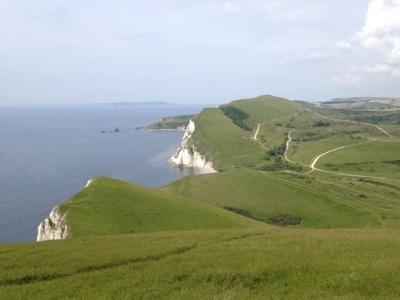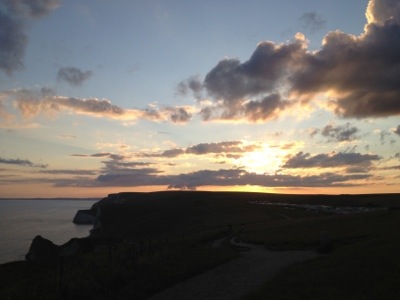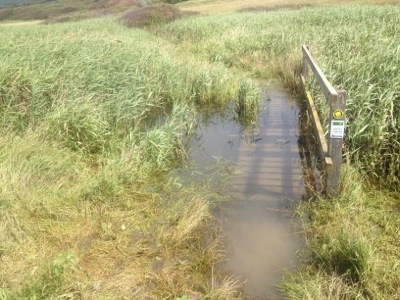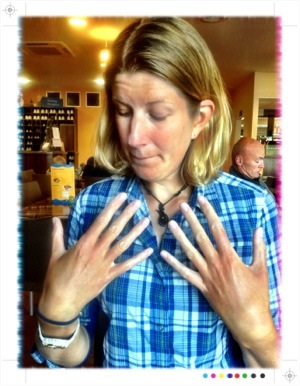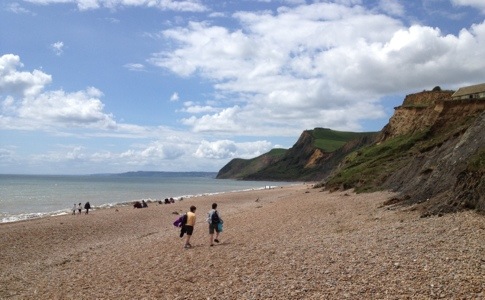As my journey drew to a close I met another hiker just setting out to walk the entire Coast Path in the opposite direction. He did it last year, he told me, and enjoyed it so much he was back to do it again in the opposite direction. I couldn’t help expressing my surprise, and may even have included the phrase ‘glutton for punishment’, but he was confident I’d feel the same way. “Not right away, of course, but give it a month or two. You’ll see.” he added, with a sage nod. Standing there on my sore feet, legs stiff and aching from yesterday’s exertions – not to mention those of the preceding 620 miles – I was more interested in finishing than in starting again, and the end was getting closer by the minute.
A few easy miles and a low hill brought us to Swanage beach, crowded with families excited that summer had finally started
We joined the happy throng with my sister, brother in law and their two children. It was a lovely reintroduction to home life after so long on the road: eating a picnic lunch, chatting with my family, jumping over the waves with my niece and watching my baby nephew discover that sand is fun in your fingers but not in your mouth. I could have sat there all afternoon but there was the small matter of the last six miles to attend to. Brushing the sand off my feet, I put my boots back on for the final time and headed back to the Path.
It was a perfect summer day, and as I climbed up to the top of Ballard Down I was grateful for the breeze to offset the heat of the sun and the walk up. Two paragliders launched as I approached the top, and wheeling low above my head in the thermals of the cliff we waved to each other as they glided by. A little further and I rounded The Foreland, my final headland, Old Harry rocks shining bright white in the late afternoon sun.
But my gaze was drawn the other way: to my first glimpse of South Haven Point, the end of the Path. I walked on to Studland and catching sight of a board outside the Manor House Hotel advertising Dorset cream teas in their stunning gardens overlooking Studland Bay it was as if fate had brought us together. I was in! But a quick call to check they were still serving revealed that, while they were open, they had sold out of scones and clotted cream after an unusually busy day. I was crushed! I walked on around Studland Bay, contemplating an ice-cream instead to console me, and there were plenty of kiosks: but my heart wasn’t in it.
When the National Trust cafe at Knoll Beach hove into view a flicker of hope was rekindled. I approached the door, hardly daring to look inside for fear of another blow: but yes! There were scones! I scanned the menu board, and there it was: “Dorset cream tea – Large (2 scones) £4.95”. Relief flooded through me; to have finished the walk without a final cream tea would have been to have left things somehow incomplete. The cream tea itself was not the best I’ve ever eaten: after a long, hot day the scones had become a little dry, and the queue to get them was tedious. But sitting in the sun on the back of the beach, just two miles from the end of the Coast Path, it was still an entrant in the cream tea challenge that will always have a special place in my heart.
Back on the trail, licking the jam off my fingers, I found the sands of Studland Bay were an altogether calmer affair than the happy chaos of Swanage Beach. Boules seemed to be the amusement of choice – I counted three separate games within 50 yards of leaving the cafe. As I moved further away from the car park the crowds thinned still more until it was just me with the oystercatchers and stints probing the sand at the waves’ edge. Oh, and some naked people.
Studland Beach, it turns out, is a popular spot for naturists. “If you’d been here a minute or two earlier I’d have posed by that sign for you,” called out a man pulling on his shirt a few metres away. I told him I thought that was above and beyond the call of duty, but it was very kind of him to offer. We parted on a less bold note – an agreement that it had been a really beautiful day – and in fact I couldn’t think of a better end to the walk. As the tide went out a wide, firm, flat expanse of sand was left beneath the clear blue sky. It couldn’t have been better for walking. Rounding the final corner I felt I could go on for ever, or at least, until I got hungry again. I was almost sorry to reach the monument marking the end. I couldn’t quite believe that, just like that, it was all over. The struggles, the frustrations, the appalling weather and the terrible conditions of the last weeks melted away under the hot sun of a perfect English summer day. I looked at the sign pointing back towards Minehead. Maybe….





